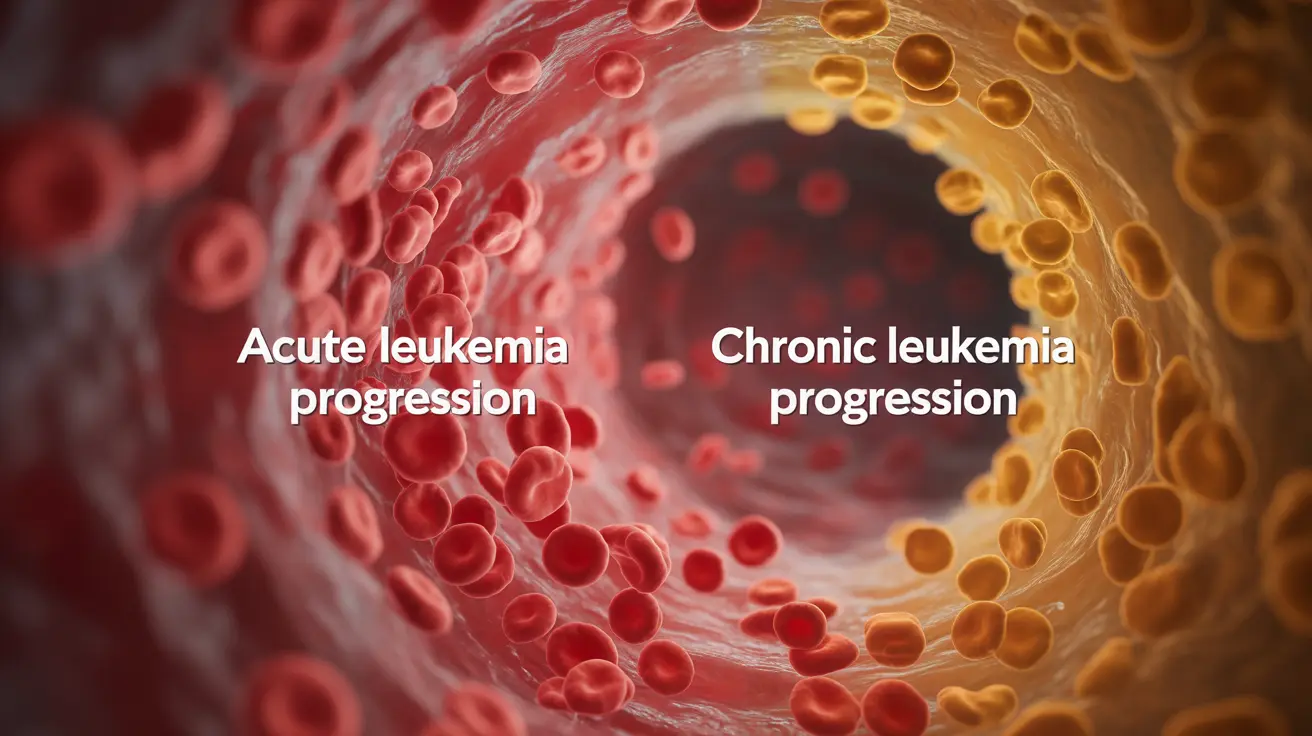Leukemia, a cancer of the blood-forming tissues, comes in two main forms: acute and chronic. Understanding the difference between acute and chronic leukemia is crucial for patients, families, and healthcare providers, as these conditions require distinctly different approaches to treatment and management.
In this comprehensive guide, we'll explore the key distinctions between these two types of leukemia, including their progression, symptoms, treatment options, and how they affect different age groups.
Main Types of Acute and Chronic Leukemia
Acute and chronic leukemia each have distinct subtypes that affect different blood cell populations:
Acute Leukemia Types
- Acute Lymphoblastic Leukemia (ALL)
- Acute Myeloid Leukemia (AML)
Chronic Leukemia Types
- Chronic Lymphocytic Leukemia (CLL)
- Chronic Myeloid Leukemia (CML)
Disease Progression and Characteristics
The fundamental difference between acute and chronic leukemia lies in how quickly the disease develops and progresses. Acute leukemia develops rapidly, with immature blood cells (blasts) multiplying quickly and interfering with normal blood cell production. Chronic leukemia, however, progresses more slowly, often allowing the body to continue producing some functional blood cells.
Symptoms and Recognition
Acute Leukemia Symptoms
- Severe fatigue and weakness
- Frequent infections
- Easy bruising and bleeding
- Bone pain
- Fever
- Rapid weight loss
Chronic Leukemia Symptoms
- Gradual onset of fatigue
- Enlarged lymph nodes
- Night sweats
- Unexplained weight loss
- Frequent infections
- Reduced exercise tolerance
Treatment Approaches
Treatment strategies differ significantly between acute and chronic leukemia, primarily due to their different progression rates and cellular characteristics.
Acute Leukemia Treatment
Acute leukemia typically requires immediate, aggressive treatment, including:
- Intensive chemotherapy
- Targeted therapy
- Stem cell transplantation
- Immunotherapy
- Radiation therapy (in some cases)
Chronic Leukemia Treatment
Chronic leukemia often allows for more flexible treatment timing and approaches:
- Watch and wait approach (in some cases)
- Targeted therapy
- Less intensive chemotherapy
- Immunotherapy
- Regular monitoring and adjusting treatment as needed
Age Distribution and Risk Factors
Acute and chronic leukemias tend to affect different age groups, though there can be overlap. Acute lymphoblastic leukemia (ALL) is more common in children, while acute myeloid leukemia (AML) and chronic leukemias typically affect older adults.
Frequently Asked Questions
What is the difference between acute and chronic leukemia in terms of symptoms and progression?
Acute leukemia progresses rapidly with severe symptoms developing within days or weeks, including intense fatigue, frequent infections, and easy bruising. Chronic leukemia develops slowly over months or years, with gradual onset of symptoms like fatigue, enlarged lymph nodes, and night sweats.
How is acute leukemia treated compared to chronic leukemia?
Acute leukemia requires immediate, aggressive treatment with intensive chemotherapy and possibly stem cell transplantation. Chronic leukemia often allows for more flexible treatment approaches, including watchful waiting, targeted therapy, and less intensive chemotherapy regimens.
What age groups are most commonly affected by acute versus chronic leukemia?
Acute lymphoblastic leukemia (ALL) primarily affects children and young adults, while acute myeloid leukemia (AML) and chronic leukemias are more common in older adults. However, these conditions can occur at any age.
Can chronic leukemia be managed without immediate treatment, and how is it monitored?
Yes, some forms of chronic leukemia can be managed with a "watch and wait" approach, particularly in early stages. Monitoring includes regular blood tests, physical examinations, and assessment of symptoms to determine when treatment should begin.
What are the main types of acute and chronic leukemia, and how do they differ?
The main types are ALL and AML (acute) and CLL and CML (chronic). They differ in which blood cell types are affected and their growth patterns. Acute types involve immature blood cells that multiply rapidly, while chronic types involve more mature cells that multiply more slowly.




